What do understand with the term “Ventilation”
Ventilation is derived from the Latin word “ventus,” which means “the movement of air” [1]. It refers to the process of continuously providing fresh air to an indoor space by removing or diluting polluted air. In other words, the distribution of healthy air for breathing inside a building by clearing out the stale air This can be achieved by various methods like natural ventilation, mechanical ventilation, and hybrid ventilation. These are essential methods that maintain good indoor air quality, and they are also crucial for various settings, including home, office, industrial facilities, and healthcare environments.
Ventilation requires airflow between interior and exterior spaces. A portion of the air in the space should be continuously withdrawn and replaced by fresh air drawn from outside to maintain the required level of air purity for the health, comfort, and safety of building occupants. Thus, it is necessary to start and maintain air flow according to requirements in a ventilated space.
Ventilation is required to control the following:-
- Oxygen content
- Carbon dioxide and moisture
- Other hazardous gases, such as CO, NOX, SO2 , etc.
- Odors and contaminants
- Bacteria
- Heat
History of ventilation
Our ancestors had solutions for every problem; that is what I believe. They do have to survive in various climatic conditions and other environmental factors. Ventilation plays a crucial role in maintaining healthy living inside a space.
Egyptians used to fan the porous jar to get cool air. Middle Eastern peoples used devices like wind scoops and wind catchers for fresh air ventilation. The Romans used a similar concept and idea to cool their tents or houses by hanging wet, thick materials on the doors. The rich people at that time constructed water channels, transporting water along the walls of their houses, to reduce the inside temperature under extremely hot climatic conditions. [9] In some parts of India, a curtain made of cascading grass is often hung in front of windows. This is wetted by throwing a bucket of water against it from time to time. [3]
These were some techniques used by ancient peoples around the world. From them, wind catchers, wind scoops, and evaporative cooling are discussed below: –
Ancient ventilation devices or methods
Wind Scoop
In some Middle East countries, “wind scoops” have been used for hundreds of years to induce natural ventilation. [1] These wind scoops rise above the roofs, and their large intake opening captures air movement above the roofs in densely built areas. The water seeping through the porous pottery jars evaporates; some drips down onto the charcoal placed on a grate, through which the air is filtered. The cooled air assists the downward movement with a reverse stack effect.
This device is very useful for ventilation, but it cannot be expected to create an air movement strong enough for physiological cooling. [3]
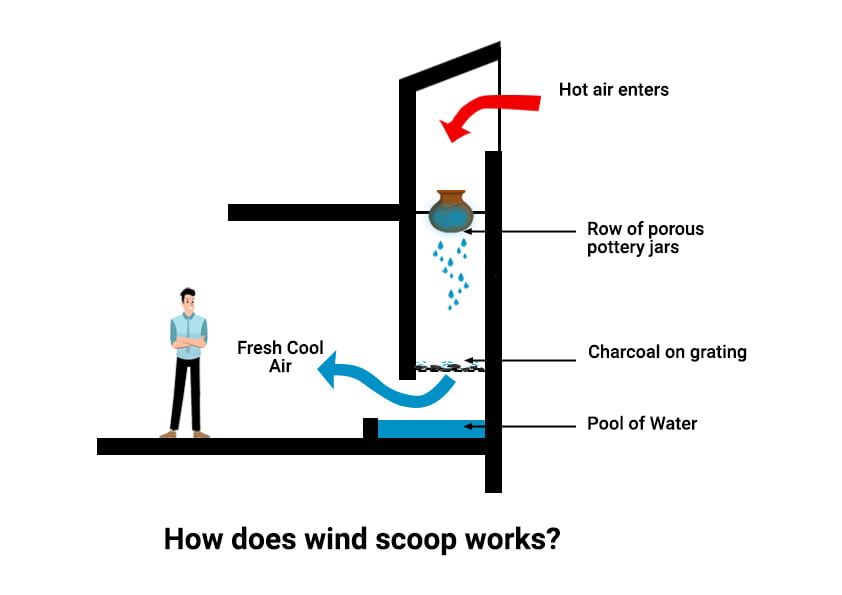
Wind Catcher or Venting Towers
A wind catcher, also known as a wind tower or venting tower, has been used for centuries in traditional Middle Eastern and Indian architecture. Wind catchers are architectural features specifically designed to capture and channel airflow into a building, promoting natural cooling. These traditional elements are used to facilitate natural ventilation and passive cooling within structures.
The tower is raised above the building roof with a bigger opening that catches the air and pulls it down through the shaft or duct. The wind catcher provides a low-carbon ventilation system that provides cool and fresh air.
To avoid turbulence from the rooftop, the size and height of the wind tower should be precisely calculated. A taller wind catcher is advised for better ventilation and fresh air. [10]
Wind catchers have been commonly used in regions such as Iran, North Africa, and Western Asia, particularly around the Persian Gulf, for over three thousand years.
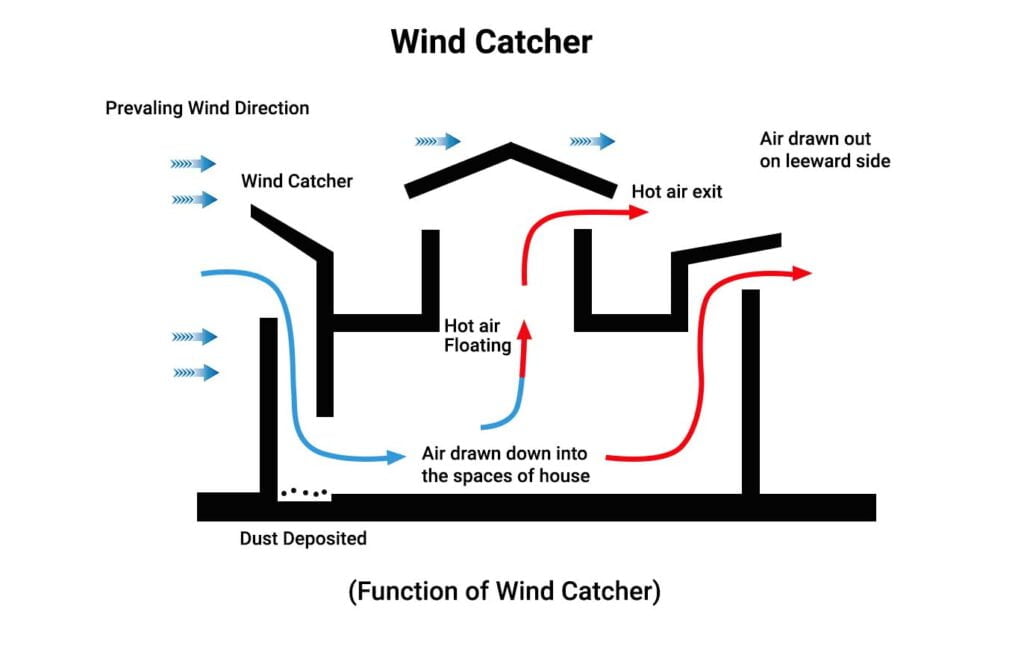
Evaporative Cooling
To read about the role of evaporative cooling in passive cooling, click here.
Evaporative cooling which is an ancient Egyptian cooling technique, to get cool and fresh air. The concept of evaporative cooling is based on the principle that when water evaporates and absorbs heat from the surroundings, which results in a cooling effect. The Egyptians were known for their advanced architectural and engineering techniques. They developed different types of methods to make their lives comfortable in any kind of climatic condition.
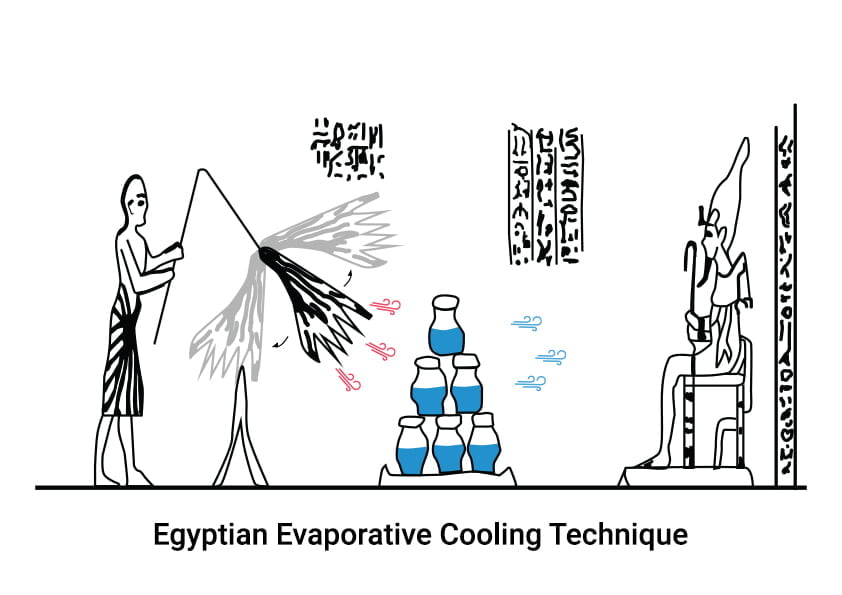
Types of Ventilation System
There are three major types of ventilation systems that can be used to ventilate a building or house: natural, mechanical, and hybrid (mixed-mode) ventilation. Each system is designed in such a way that it meets the specific needs and requirements of the users. All three types are discussed below: –
Natural Ventilation
Natural ventilation, sometimes referred to as passive ventilation, is a type of ventilation in which air exchange is provided by natural factors such as temperature differences, wind, and air movement. [4] It uses prevailing winds to direct fresh air inside the space through openings in the building envelope without the use of any mechanical devices. The openings in the building envelope include doors, windows, arches, ventilators, shafts, jali, wind towers, or any other openings. Fresh air enters through these openings and creates pressure or temperature differences inside the building that help both passively cool and ventilate the building. [8] Openings in a building envelope can be designed smartly to increase or decrease the speed of the air movement and get the maximum air inside the envelope.
Natural ventilation in buildings is meant to cool the body right away through convection across the skin and the absorption of perspiration. [1]
Benefits of Natural Ventilation
- It improves the indoor air quality.
- Energy savings
- Reduces greenhouse gas emissions
- It brings positivity and reduces stress.
- A well-designed natural ventilation system can be used to access a higher level of daylight inside the building.
Design Considerations for natural ventilation
- Design a good layout where cool air enters through an opening and warm air exits through another one.
- Orient buildings between 0 and 30 degrees along the prevailing wind for better air circulation.
- A sill height of 85% can attract maximum air movement.
- Good airflow can be achieved by having the same size and height of openings.
- The total window wall (WWR) ratio should be 30% of the floor area.
- Design windows along the breezeways to collect cool air. (Casement windows are preferred here.)
Mechanical Ventilation
Mechanical ventilation, sometimes referred to as artificial ventilation, is a type of ventilation in which air exchange is provided by artificial or mechanical elements to get fresh or cool air and ventilate the building. It uses mechanical devices to direct the air inside the building; it can be installed on the building envelope or inside the space. Devices like fans, AC, supply ducts, filters, air diffusers, etc. are directly installed on the windows or walls to supply the air or exhaust air from the room.
We don’t just rely on natural ventilation to get fresh air inside; we can simply use these devices to cool themselves. The mechanical system can works well in different climatic conditions and can be adjusted to any mode as per the users convenient and requirements.
Benefits of Mechanical Ventilation
- Mechanical ventilation can be designed wherever electricity is available.
- Better indoor air quality.
- More control over the air circulation and movement
- Provides improved comfort through constant air flow, filtration, and conditioning.
Design Consideration for Mechanical Ventilation
- The mechanical devices should be designed for a space after studying the air demand in that space.
- The ventilation rate should be considered before preparing a layout for devices.
- The devices should be designed wherever it is necessary to save energy.
- Proper consideration should be given while designing the inlet and outlet, as it helps in cleaning the air.
Three types of mechanical ventilation systems:
- Natural inlet and mechanical extract (exhaust system)
- Mechanical inlet and natural extract
- Mechanical inlet and extract
To read about them in detail with diagrams, click here.
Hybrid Ventilation
Hybrid ventilation is known as a mixed-mode ventilation system that uses both natural and mechanical methods to provide fresh and cool air to the occupants. When the desired air flow rate is not achieved by natural ventilation, mechanical elements like fans and AC come into play and fulfill the air demands of the occupants. This type of ventilation system needs a proper understanding of the mechanical and natural ventilation methods to fulfill the occupants air demands.
Benefits of Hybrid Ventilation
- Can be controlled easily.
- Manual control of ventilation can save energy demands in an instant.
- Can create better air flow or movement inside a space.
Design Consideration for Hybrid Ventilation
- Designed mixed-mode ventilation options wherever it is necessary.
- Try to avoid unnecessary openings in front of mechanical devices.
- A ratio of 60:40 (60 natural and 40 mechanical) is appropriate for hybrid ventilation.
Factors which affect the Indoor Air Flow
Indoor air flow can be affected by various factors, including the building’s form, design, environmental conditions, etc. Understanding these factors is crucial for maintaining good indoor air quality and optimizing ventilation. Some of the factors are discussed below: –
Orientation
The greater pressure on the windward side of a building is generated when the elevation is at right angles to the wind direction, so it seems obvious that the greatest indoor air velocity will be achieved in this case. A wind incidence of 45° would reduce the pressure by 50%.
Thus, the architect must ascertain the prevailing wind direction and must orient his building in such a way that the largest openings are facing the wind direction. [3]
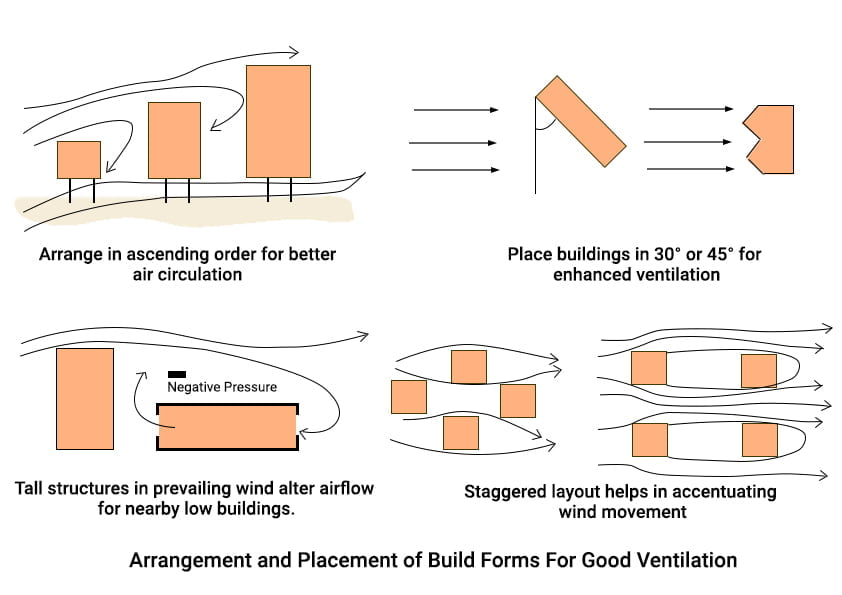
External Features
External features of the building can strongly influence the pressure built up. The positions of these external features can either increase or decrease wind pressure in front of the windows or openings. Wind walls, windscreens, trees, extended walls, etc. are considered external features. [3]
Trees and shrubs can also be used as windscreens, as they have punchers and are suitable to redirect the air so that it can have some advantages for people by directing cool air to them. [1]
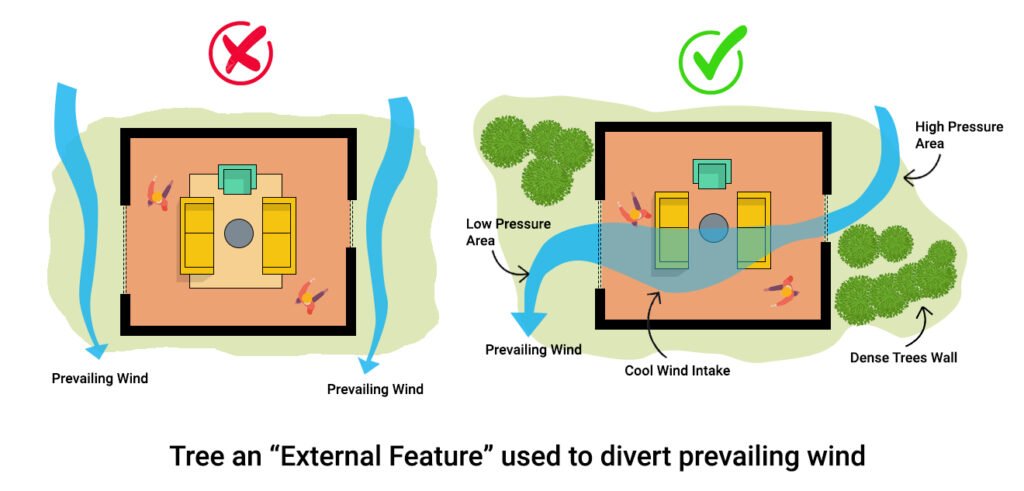
Cross Ventilation
This technique involves the use of strategically placed openings in opposite pressure zones of the building to allow for the flow of cool air in and warm air out. Inlet from where the cool air enters and outlet from where the warm air exits. The position and size of the inlet and outlet depend on the direction of the wind and its velocity. Ideally, the same size of inlet and outlet is taken into consideration, but playing with size can also create good results. The main purpose of cross ventilation is to provide fresh air and remove hot air to make the inside healthier for the occupants.
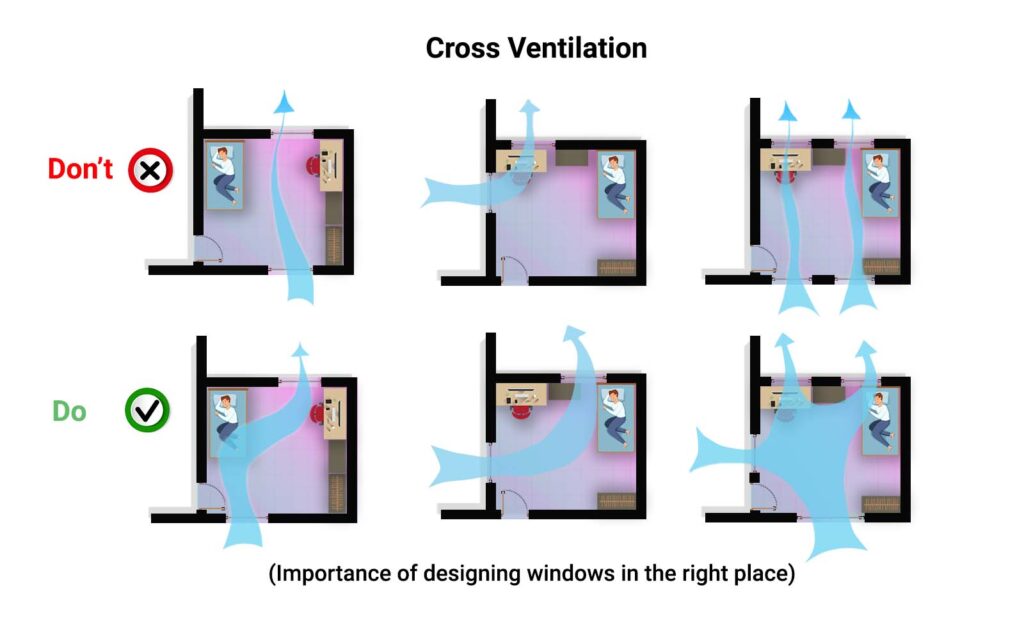
Position of Openings
To be effective, the air movement must be directed at the body surface. In building terms, this means that air movement must be ensured through the spaces mostly used by the occupants. If the openings are not designed in the desired location, the air flow will take place where it will not provide any benefit to the occupant. [3]
Size of Openings
The largest air velocity can be obtained through a small inlet opening with a large outlet. This is partly due to the total force acting on a small area, forcing air through the opening at high pressure, and partly due to the “venture effect”. Such an arrangement may be useful if the air stream is to be directed at a given part of the room.
The best arrangement is full wall openings on both sides with adjustable sashes or closing devices. Which can assist in channeling the air flow in the required direction following the change of wind. [3]
Controls of Openings
Sashes, canopies, louvres, and other elements controlling the openings, also influence the indoor air flow pattern.
Sashes: It can divert the air flow upwards. Only a casement or reversible pivot sash will channel it downwards into the living zone.
Canopies: It can eliminate the effect of pressure built-up above the window, thus the pressure below the window will direct the air flow upwards. A gap left between the building face and the canopy would ensure a downward pressure, thus a flow directed into the living zones.
Louvres and shading devices may also present a problem. The position of louvres in a slightly upward position would still channel the flow into the living zone (up to 20° upwards from the horizontal)
Stack Ventilation
The stack effect is passive ventilation that uses the air pressure differences due to height to pull the air through the building. Lower pressures in the buildings help pull the air in an upward direction. It is because the hot air rises. The stack effect is useful in exhausting unwanted air from the building that might be stuck below the ceiling, in skylights, or anywhere up. This effect creates an exchange of air in the absence of outside wind pressure. The effect seems familiar to the “tee-pee” design. Where the openings at the top allow heated air to escape through the openings and cooler air replacements enter from the lower bottom openings. [1]
According to architecture, outdoor air that is away from the ground is less obstructed. That’s why it moves faster than lower air and therefore has lower pressure. This lower pressure can help in sucking fresh air through the building. A building’s surroundings can be greatly affected by this strategy by causing more or less obstruction. [7]
In lower buildings, this effect can be particularly effective at night. When cooler air can be brought inside the buildings to remove the hot air that has been absorbed by the building materials during the day. [1]
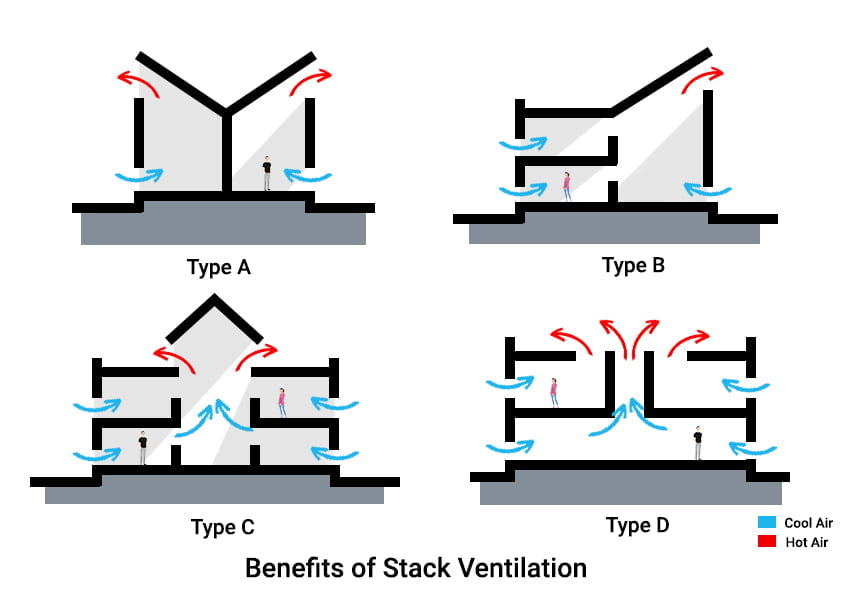
Purpose of Ventilation
In an occupied space, the air should be in a condition to meet our comfort requirements. The following comfort-relevant parameters can be influenced by ventilation systems:
- Cleanliness of air and odor levels and maintenance of air quality
- Regulating the room air temperature
- Controlling the air movement and humidity inside the space
- Providing fresh air and removing the stale air.
- Provide comfort and productivity for the occupants.
- Maintain the building codes, as many have provisions for them.











